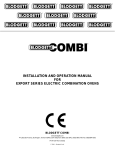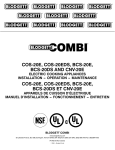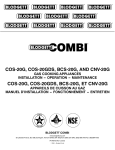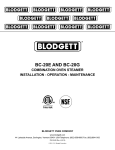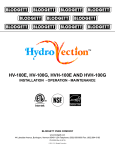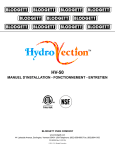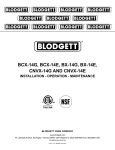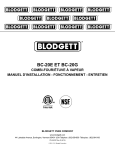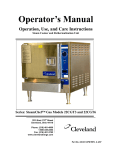Download Blodgett COMBI COS-20G Operating instructions
Transcript
COS-20G INSTALLATION AND OPERATION MANUAL FOR EXPORT SERIES GAS COMBINATION OVENS BLODGETT COMBI www.blodgett.com 44 Lakeside Avenue, Burlington, Vermont 05401 USA Telephone (800) 331-5842, (802) 860-3700 Fax: (802)864-0183 PN R8203 Rev D (6/01) E 2000 --- Blodgett Combi Table of Contents Introduction The Blodgett Combi-Oven/Steamer . . . . . . . . . . . . . . . . . . . . . . . . . . . . . . . . . Description of the Combi-Oven/Steamer . . . . . . . . . . . . . . . . . . . . . . . . . . . . Oven Features . . . . . . . . . . . . . . . . . . . . . . . . . . . . . . . . . . . . . . . . . . . . . . . . . . . 2 3 4 Installation Owner’s Responsibilities . . . . . . . . . . . . . . . . . . . . . . . . . . . . . . . . . . . . . . . . . . Location and Ventilation . . . . . . . . . . . . . . . . . . . . . . . . . . . . . . . . . . . . . . . . . . . Utility Connections . . . . . . . . . . . . . . . . . . . . . . . . . . . . . . . . . . . . . . . . . . . . . . . Adjustments . . . . . . . . . . . . . . . . . . . . . . . . . . . . . . . . . . . . . . . . . . . . . . . . . . . . . Final Check Lists . . . . . . . . . . . . . . . . . . . . . . . . . . . . . . . . . . . . . . . . . . . . . . . . . 5 6 7 9 10 Operation Safety Information . . . . . . . . . . . . . . . . . . . . . . . . . . . . . . . . . . . . . . . . . . . . . . . . Oven Start-Up . . . . . . . . . . . . . . . . . . . . . . . . . . . . . . . . . . . . . . . . . . . . . . . . . . . Standard Controls . . . . . . . . . . . . . . . . . . . . . . . . . . . . . . . . . . . . . . . . . . . . . . . . Optional Cook & Hold . . . . . . . . . . . . . . . . . . . . . . . . . . . . . . . . . . . . . . . . . . . . Optional Meat Probe . . . . . . . . . . . . . . . . . . . . . . . . . . . . . . . . . . . . . . . . . . . . . . 12 13 14 16 19 Maintenance Spray Bottle Operating Procedure . . . . . . . . . . . . . . . . . . . . . . . . . . . . . . . . . . Cleaning and Preventive Maintenance . . . . . . . . . . . . . . . . . . . . . . . . . . . . . . Decalcification . . . . . . . . . . . . . . . . . . . . . . . . . . . . . . . . . . . . . . . . . . . . . . . . . . . 20 21 22 Introduction The Blodgett Combi-Oven/Steamer For easy operation you can choose from three modes: For quite some time, commercial cooking equipment has remained more or less unchanged. There are kettles, deck ovens, the good old range with its legion of pots and many other extra appliances. The result: time expenditure, excessive manual work, and countless cleaning processes. The last few years have paved the way for a revolution in the equipment of restaurant and institutional kitchens. All Blodgett Combi appliances improve your kitchen through: D D D Steam In the Steam mode you can: D D increased productivity a wider range of menu choices a simplified cleaning process D steam defrost D D blanch rethermalize D poach D braise In the Hot Air mode you can D roast D bake In the Combi mode you can: defrost D roast reheat D bake D proof* D cook & hold* * with optional digital controls D D D D rethermalize sous vide* The COS-20G model includes a built in steam generator. This unit includes an inlet, funnel assembly and valve lever for decalcification. With the Oven/Steamer you have the choice of two cooking processes: Steam and Hot Air, either... D Combi Steam & Hot Air The work process is simplified since products are prepared on or in steam table pans and trays. Food can be cooked, stored, and transported with the same pans. Small amounts of product can be processed efficiently; pre-cooked and convenience foods can be reheated within minutes. D Hot Air Separately Combined, or In Sequence using two or three functions during one cooking process. We call this combi-steaming and combi-baking. 2 Introduction Description of the Combi-Oven/Steamer ABOUT THE OVEN/STEAMER OVEN/STEAMER OPERATION Blodgett Combi-Oven/Steamers are quality produced using high-grade stainless steel with first class workmanship. The practical oven door, with a viewing window, has a wide swing radius and handle which can be operated easily, even with wet or greasy hands. The high performance fresh steam generator with its control system makes it possible to enjoy all of the advantages of a high quality steamer at the flick of a switch. Fresh steam enters the oven cavity without pressure and is circulated at high speed. This process enables quick and gentle cooking and ensures high quality food while providing convenient working methods. The steam generator is completely automatic and protected from running dry. Ease of operation is guaranteed through the simple arrangement of the controls. Graphic symbols make the appliance easy for even inexperienced kitchen staff to operate. Steam, Hot Air and Combi modes can be selected with one switch. A fourth function on the mode selection switch, the Cool Down mode, allows the oven cavity to cool down rapidly with the door opened or closed. Cleaning is kept to a minimum. The interior is sprayed with a self-acting cleaning solution which interacts with steam to easily remove crusts and stains. The oven is designed for easy care and is welded water tight so that the internal cooking cavity may be rinsed with a hose after the steam cleaning process. A patented quench system keeps the air in the oven clean. Fumes which arise from roasting and grilling are sucked from the appliance, quenched, and directed out through the condenser drain. The exhaust system is effective in all cooking modes and results in better quality foods and no flavor transfer. The fan, which is guarded against accidental finger contact, is driven by a quiet and powerful motor. The condenser draws out excess steam from the appliance. Condensation and waste water, which result during steaming and cleaning, are continuously drained. The use of high quality insulation impedes excessive heat radiation and saves energy. 3 Introduction Oven Features Standard Features 4 2 3 5 1 6 COS-20G Figure 1 1 Control Panel 4 Vent (not shown) 2 Oven Door 5 Decalcifying Inlet & Funnel Assembly 3 Door Handle 6 Decalcifying Valve Lever 4 Installation Owner’s Responsibilities 1. Oven(s) are uncrated, stacked (if applies) and put in place. 2. The owner/operator must have the following utility requirements met and installed. NOTE: Refer to the Utility Connection information provided. MAXIMUM SHELF LOADING COS-20G ELECTRICAL 15 amp grounded outlet PLUMBING Water Water pressure 345 kPa to unit Cold water supply 19 mm hose fitting Hot water supply 19 mm hose fitting Drainage Atmospheric vented drain Drain connection 5 cm copper Average water drain temperature Approximately 50_C GAS PRESSURE Gas Connection BSP/ISO 3/4-14 7/1 Orifice at Sea Level Steam (gas type --- G20) 5.156 mm diameter Hot Air (gas type --- G20) 2.00 mm diameter Inlet Pressure to the Unit Gas type --- G20 20 mbar Hot Air Pressure Gas type --- G20 7.6 mbar Steam Pressure Gas type --- G20 8.6 mbar CALORIFIC INPUT (Nett) Steam 29.0 KW Hot Air 49.8 KW 5 45,5 Kg (100 lbs) Installation Location and Ventilation LOCATION VENTILATION The well planned and proper placement of your appliance will result in long term operator convenience and satisfactory performance. The necessity for a properly designed and installed ventilation system cannot be over emphasized. The ventilation system will allow the unit to function properly while removing unwanted vapors and products of combustion from the operating area. The following clearances must be maintained between the unit and any combustible or non-combustible construction. The appliance must be vented with a properly designed mechanically driven exhaust hood. The hood should be sized to completely cover the equipment plus an overhang of at least 15 cm on all sides not adjacent to a wall. The capacity of the hood should be sized appropriately and provisions made for adequate makeup air. Right side of unit --- 15 cm D Left side of unit --- 15 cm D Back of unit --- 15 cm NOTE: For models with hose assemblies on the back of the unit, the hose must be 15 cm from the wall. D The following clearances are recommended, but not required, for servicing. D D WARNING!! Failure to properly vent the oven can be hazardous to the health of the operator; and will result in operational problems, unsatisfactory baking, and possible damage to the equipment. Damage sustained as a direct result of improper ventilation will not be covered by the Manufacturer’s warranty. Left side of unit --- 30 cm Back of unit --- 30 cm Place the unit in an area which is free of drafts and accessible for proper operation and servicing. Keep the operating area free and clear of all combustibles such as paper, cardboard, and flammable liquids and solvents. Installation must conform with Local and National installation standards. Local installation codes and/or requirements may vary. If you have any questions regarding the proper installation and/or operation of your unit, please contact your local distributor. If you do not have a local distributor, please call Blodgett Combi at 0011-802-860-3700. DO NOT place the unit on a curb base or seal to the wall; either condition will prevent proper ventilation to the blower motors. Slight unevenness can be corrected with the adjustable legs. Heat sources should not be located near the air vents on the left hand side of the unit. Consult the factory for an optional protective side heat shield kit if a warm surface or water source is to the left of the unit. On all models, tripping the blower motor’s thermal overload device indicates an excessive ambient temperature on the side of the oven. This must be corrected to prevent permanent damage to the oven. All motor bearings are permanently lubricated by the manufacturer; there is no need for additional lubrication during the operational lifetime of the motors. 6 Installation Utility Connections NOTE: Utility connections must be performed by a qualified installer only. DRAIN CONNECTION A 5 cm copper pipe with standard drain pitch must be run to an open drain or connected to a standpipe equipped with a vent. WATER CONNECTION NOTE: Hot water maximizes steam production but is not required. Cold water may be supplied to both inlets if hot water is not available. NOTE: The waste water can also be directed to a nearby floor drain. Flexible hose which allows trapped water to accumulate in sagged runs must be avoided. Connect the appliance to quality cold water via a pressure hose with 19 mm couplings. Cold water is connected to the left solenoid/pressure regulator as views from the rear of the oven. Hot water connection, right solenoid/pressure regulator, to the boiler is recommended. A shut off valve must be provided adjacent to the oven. 1. Find the drain connection on the lower rear of the unit. 2. Loosen the coupling clamps. Attach a 5 cm copper drain pipe to the drain connection. Retighten the coupling clamps. NOTE: The open end of the drain should be installed facing the floor. Copper line, used for installation to an open drain or floor sink, must be supplied by the installer. Use of a trap inline will cause drain backup. 13mm appliance hose with 19 mm hose fittings Figure 2 5 cm Drain Customer Supplied Water must meet the following minimum requirements: D D Total Dissolved Solids (TDS) content will not exceed 30 parts per million. Water PH must be 7.0 or higher Oven Drain To Drain Figure 3 WARNING!! The use of poor quality water will invalidate your warranty. 7 Installation Utility Connections ELECTRICAL CONNECTION GAS PIPING AND PRESSURE Before making any electrical connections to these units, check that the power supply is adequate for the voltage, amperage, and phase requirements stated on the rating name plate mounted on the appliance. A properly sized gas supply system is essential for maximum oven performance. Piping should be sized to provide a supply of gas sufficient to meet the maximum demand of all appliances on the line without loss of pressure at the equipment. A strain relief for the power supply cord is required. The installer must supply a cord bushing that meets all Local and National installation standards. Pressure Regulation and Testing The gas pressure to the appliance must be rated for 20 mbar while the burners are on. A sufficient gas pressure must be present at the inlet to satisfy these conditions. The circuit breaker that is used to provide power to this appliance must have a minimum of 3mm contact spacing. The circuit breaker must meet all Local and National installation standards. Each unit has been adjusted at the factory to operate with the type of gas specified on the rating plate attached to the right side of the unit. All ovens must be installed in accordance with Local or National Electrical codes. Each oven is supplied with gas regulators to maintain the proper gas pressure for steam and hot air production. The regulators are essential to the proper operation of the oven and should not be removed. The hot air system is regulated to 7.6 mbar. The steam system is regulated to 8.6 mbar. A wiring schematic is located on the inside of the removeable side panel. NOTE: Disconnect the power supply to the unit before servicing. DO NOT INSTALL AN ADDITIONAL REGULATOR WHERE THE OVEN CONNECTS TO THE GAS SUPPLY. WARNING!! Improper electrical installation will invalidate your warranty. The oven and its individual shutoff valve must be disconnected from the gas supply piping system during any pressure testing of that system at test pressures in excess of 35 mbar. The oven must be isolated from the gas supply piping system by closing its individual manual shutoff valve during any pressure testing of the gas piping system at test pressures equal or less than 35 mbar. Prior to connecting the unit, gas lines should be thoroughly purged of all metal filings, shavings, pipe dope, and other debris. After connection, the unit should be checked for correct gas pressure. Installation must conform with Local and National installation standards. Local installation codes and/or requirements may vary. If you have any questions regarding the proper installation and/or operation of your unit, please contact your local distributor. If you do not have a local distributor, please call Blodgett Combi at 0011-802-860-3700. 8 Installation Adjustments BEFORE SWITCHING THE APPLIANCE ON DOOR ADJUSTMENT Before applying power to the unit for the first time, check for the following conditions: The hinges may be adjusted using the following procedure: 1. Adjust the top hinge plate by loosening the three mounting bolts on the top right corner of the unit. 2. Adjust the bottom hinge pin by loosening the mounting bolt located under the bottom hinge plate on the lower right corner of the oven. 3. Adjust the hinges so that the door back and the unit face are parallel. 4. Tighten the bolts so that there is no further movement. 5. The adjustment is correct when the door closes firmly and no steam leaks from the gasket. The hinges can also be adjusted as follows: j The unit is level. j All electrical safety provisions have been ad- hered to and the electrical connections are correct. j The circulation blower wheels should turn counter-clockwise: check rotation from inside the oven cavity. j Water is connected, turned on and all of the connections are water tight. j Check gas fittings with leak detection solution. j The transport cart is inserted into the cooking cavity. When the cart is not inserted into the unit, water can spill onto the floor causing it to become slippery. If the door will not close properly, use the 1. Adjust the door catch by loosening the four mounting screws located on the inside surface of the oven door. 2. The adjustment is correct when no steam leaks from the gasket. NOTE: The first time the unit is turned on, or after the unit has been OFF for 5 hours and then turned on, it will automatically flush the steam generator for a period of 75 seconds. The steam generator will then fill to the proper water level. The unit is now ready for operation. Oven Door Oven Door COS-20G Figure 4 9 Installation Final Check Lists NOTE: Final check list must be performed by a qualified installer only. ELECTRICAL CONTROL COMPARTMENT Applied voltage to unit voltage/phase suitable for appliance specified. j j j j j Remove side panel Set motor protector (F2) to on position Adjust motor protector to maximum Reset high limit thermostats F3 and F6 Reinstall side panel GAS FINAL CHECK j Verify inlet pressure is 20 mbar. Turn manual gas valve to on. Turn mode selector switch to STEAM. NOTE: On initial startup, the steam generation system may go into lockout mode until all air has been purged from the gas line. To reset the steam generator system, turn the mode selector to OFF, then back to STEAM. Repeat until the steam generator burner ignites. j Verify the regulator pressure is set at 8.6 mbar. j Check for gas leaks using leak detection solu- PLUMBING FINAL CHECK j Incoming water pressure within 276 kPa (minimum) --- 345 kPa (maximum) j Atmospheric vented drain in place j Water solenoid properly bracketed and not leaking j Water feed lines intact without leaks j Optional Spray Hose connected properly. Connect the optional spray hose to the fill solenoid as shown. tion. Turn the mode selector switch to HOT AIR. NOTE: On initial startup, the hot air system may go into lockout mode until all air has been purged from the gas line. Lockout mode is indicated by the amber lamp near the manual gas valve. If lockout occurs, press the reset switch to initiate hot air startup. Repeat until hot air ignition occurs. j Verify hot air manifold pressure is set at 7.6 mbar. Washer j Check for gas leaks using leak detection solu- Regulator Assembly “Y” Fitting tion. Cold water supply Fill Solenoid Washer Hose and Spray Spray Hose Connection Figure 5 10 Installation Final Check Lists OVEN OPERATIONAL TESTS NOTE: Checks to be made by customer or authorized service agent. Cool Down Mode j Check fan rotation is correct, counter clockwise from inside of the oven Combi Mode Turn to COMBI mode, set thermostat to 177_C and verify: j Boiler flushes and fills j Boiler preheats to 85_C then switches to HOT AIR j When HOT AIR reaches 177_C, HOT AIR shuts off and STEAM comes on Steam Mode Turn on STEAM mode and verify (control panel removed): j Check timer operation in all three positions a.) Set timer to OFF position, buzzer should sound b.) Set timer in position other than OFF or STAY ON, timer should count down c.) Set timer in STAY ON position, oven should operate continuously without timer j Run light (power light) turns on j Unit produces steam, window fogs, door seal does not leak j Quenching system working 11 Hot Air Mode Turn to HOT AIR mode and set thermostat to 204_C and verify: j Heat demand light is on j Oven is heating properly j Heat lights shuts off at 204_C and oven maintains 204_C. Operation Safety Information THE INFORMATION CONTAINED IN THIS SECTION IS PROVIDED FOR THE USE OF QUALIFIED OPERATING PERSONNEL. QUALIFIED OPERATING PERSONNEL ARE THOSE WHO HAVE CAREFULLY READ THE INFORMATION CONTAINED IN THIS MANUAL, ARE FAMILIAR WITH THE FUNCTIONS OF THE OVEN AND/OR HAVE HAD PREVIOUS EXPERIENCE WITH THE OPERATION OF THE EQUIPMENT DESCRIBED. ADHERENCE TO THE PROCEDURES RECOMMENDED HEREIN WILL ASSURE THE ACHIEVEMENT OF OPTIMUM PERFORMANCE AND LONG, TROUBLE-FREE SERVICE. Please take the time to read the following safety and operating instructions. They are the key to the successful operation of your Blodgett Combi gas appliance. SAFETY TIPS What to do if you smell gas: D D D NOTE: In the event of a shut-down of any kind, allow a five (5) minute shut off period before attempting to restart the oven. General safety tips: D D D For your safety read before operating D What to do in the event of a power failure: Turn all switches to off. D DO NOT attempt to operate the unit until the power is restored. D DO NOT try to light any appliance. DO NOT touch any electrical switches. Use an exterior phone to call your gas supplier immediately. If you cannot reach your gas supplier, call the fire department. 12 DO NOT use tools to turn off the gas control. If the gas cannot be turned off manually do not try to repair it. Call a qualified service technician. If the oven needs to be moved for any reason, the gas must be turned off and disconnected from the unit before removing the restraint cable. Reconnect the restraint after the oven has been returned to its original location. DO NOT remove the control panel cover unless the oven is unplugged. Operation Oven Start-Up INITIAL OVEN START-UP COMBI MODE (if applicable) 1. Turn the manual gas valve to ON. 1. Turn the mode selector switch to COMBI. 2. The combustion blower turns on. STEAM MODE (if applicable) 3. The green POWER indicator lamp on the front control panel lights. 1. Turn the mode selector switch to STEAM. 2. The combustion blower turns on. 3. The green POWER Indicator lamp on the front control panel lights. 4. The steam generator flushes and drains automatically for 75 seconds if the unit has been off for at least 5 hours. 5. The steam generator begins to fill. After two minutes, the FILL indicator lamp on the front control panel blinks. The convection blower and POWER lamp turn off. 6. When the steam generator is filled to the proper level and preheated, the convection blower, interior lights and POWER indicator lamp turn on. 7. Several relay contacts change state. A click is heard when the gas valve opens. 8. The steam generator main burner ignites. 9. Steam fills the cavity and is controlled by a non-accessible internal thermostat. HOT AIR MODE (if applicable) 4. Set the Hot Air thermostat to the desired temperature. 5. The steam generator flushes and drain automatically for 75 seconds if the unit has been off for at least 5 hours. 6. The steam generator begins to fill. After two minutes the FILL indicator lamp on the front control panel blinks. The convection blower and POWER lamp do not shut down. 7. When the steam generator is filled to the proper level, several relay contacts change state. A click is heard when the gas valve opens. 8. When the steam generator comes up to a predetermined temperature, the hot air thermostat lamp illuminates, indicating the cavity temperature is below the desired set point. 9. Two series of clicks are audible as the hot air pilot burners and main burners ignite. 10. When the cavity temperature reaches the desired set point, the temperature indicator lamp goes off. The main burners shut off. 11. The steam and hot air burners toggle back and forth responding to the thermostat set points. 1. Turn the mode selector switch to Hot Air. 2. The convection blower turns on. 3. Set the hot air thermostat to the desired temperature. 4. The thermostat lamp lights, indicating the cavity temperature is below the desired set point. 5. Two series of clicks are audible as the hot air pilot burners and main burners ignite. 6. When the cavity temperature reaches the desired set point, the temperature indicator lamp goes off. The main burners shut off. 13 Operation Standard Controls CONTROLS IDENTIFICATION 1. LOW WATER FILL LIGHT --- during the fill cycle, this light remains on until the water in the steam generator is at the proper level and up to temperature. During normal operation the light should not be on. If the light comes on, check the water level in the steam generator. 2. DON’T STEAM LIGHT --- indicates the unit is too hot to operate in the steam mode. Place the unit in the Cool Down mode until the temperature is below 230_F (110_C) and open the door. This light does not inhibit steam production. 3. POWER ON LIGHT --- indicates the unit is in Steam, Hot Air or Combi. 4. MODE SELECTOR SWITCH --- turns power to the oven on or off. Allows selection of Steam, Hot Air, Combi or Cool Down modes. 5. TEMPERATURE DIAL --- used to set desired cooking temperature. 6. HEATING INDICATOR LIGHT --- lights when the Hot Air heating is in operation. 7. TIMER DIAL --- used to set desired cooking time. 8. FLUSH/DRAIN SWITCH --- used to flush/ drain the steam generator for decalcification. 9. LOCKOUT LIGHT --- lights when hot air control system is in lockout mode. 10. RESET SWITCH --- used to reset the hot air control system after a lockout condition. 2 1 3 4 5 6 7 8 9 10 COS-20G Shown Figure 6 14 Operation Standard Controls OPERATION 1. Turn the MODE SELECTOR Switch (4) to the desired function. The POWER ON Light (3) illuminates. 2. Set the TIMER (7) for the desired cooking time or set it to STAY ON. The buzzer sounds and the unit shuts off when the time has expired. 3. For the HOT AIR and COMBI modes, set the TEMPERATURE Dial (5) to the desired cook temperature. The HEATING INDICATOR Light (6) illuminates and stays lit until the desired temperature is reached. The temperature dial does not operate during the STEAM portion of the COMBI mode. 4. The selected mode operates automatically. The temperature, time and mode can be altered at any time during the cooking process. The operation can be stopped by the use of the Mode Selector Switch or by opening the door. 15 5. At the end of the specified time period, the buzzer sounds and the appliance will shut off automatically. Move the TIMER (7) to the STAY ON position to stop the buzzer and restart the unit. 6. To cool down the oven cavity, switch the MODE SELECTOR Switch (4) to COOL DOWN. In the Cool Down mode neither the temperature dial or the timer will be operational. The blower will function with the door open or closed. 7. The mode selector switch is also the main power switch. In the OFF position the appliance is not operational. Operation Optional Cook & Hold CONTROLS IDENTIFICATION 1. LOW WATER FILL LIGHT --- during the fill cycle, this light remains on until the water in the steam generator is at the proper level and up to temperature. During normal operation the light should not be on. If the light comes on, check the water level in the steam generator. 2. DON’T STEAM LIGHT --- when lit indicates the unit is too hot to operate in the steam mode. 3. POWER ON LIGHT --- when lit indicates power to the unit is turned on. 4. MODE SELECTOR SWITCH --- controls power to the oven and selection of steam, hot air and combi modes. The convection fan runs with the switch in steam, hot air, combi or cool down. 5. TIME DISPLAY --- shows cook time. 6. TIME ARROW KEYS --- press to enter cook time from 00:00 to 99:59. 7. TEMPERATURE DISPLAY --- shows cook temperature. 8. HEAT LIGHT --- when lit indicates hot air or steam is in operation. 9. TEMPERATURE ARROW KEYS --- press to enter cook temperature from 120---212_F (48---100_C) for steam and 140---500_F (60---260_C) for hot air/combi. 10. STAGE ONE LED --- when lit indicates operation or programming of stage one for the current product. Cook cycles may contain one or two different stages. 11. ACTUAL TEMP KEY --- press to display actual oven/steamer temperature 12. STAGE TWO KEY --- press to enter stage two cook time and temperature. 13. PRODUCT KEYS --- three programmable keys. 14. MANUAL PRODUCT KEY --- default product key used for manual and programmed cooking. 15. START KEY --- press to begin a cook cycle. 16. STOP KEY --- press to silence audible alarms and pause or cancel cook cycles. 2 1 3 4 5 7 8 6 10 9 11 12 13 14 15 16 17 18 19 20 COS-20G Shown Figure 7 16 Operation Optional Cook & Hold 17. PROGRAM KEY --- press to enter programming mode and save programmed settings. 18. FLUSH/DRAIN SWITCH --- Used to flush/ drain the steam generator for decalcification. 19. LOCKOUT LIGHT --- lights when hot air control system is in lockout mode. 20. RESET SWITCH --- used to reset the hot air control system after a lockout condition. MANUAL OPERATION 1. Turn the SELECTOR SWITCH (4) to the desired mode. The LED above the manual key lights. 2. Press the TEMPERATURE ARROW KEYS (9) to set the stage one cook temperature. 3. Press the TIME ARROW KEYS (6) to set the stage one cook time. 4. Press the STAGE TWO KEY (12). NOTE: Stage two can be used for either a hold mode or a second cook temperature. Example: Cook meats or poultry at a low temperature for maximum moisture retention, then set the second stage for browning. To use the second stage for holding, you must set an appropriate hold time for the unit to count down from. NOTE: If stage two is not required enter a cook time of 00:00. 5. Press the TEMPERATURE ARROW KEYS (9) to set the stage two cook temperature. 6. Press the TIME ARROW KEYS (6) to set the stage two cook time. 7. Press the START KEY (15) to begin the cook cycle. The STAGE ONE LED (10) lights. The TIME DISPLAY (5) counts down the stage one cook time. If stage two is selected an alarm sounds at the end of stage one. The time display counts down the stage two cook time. 8. When all cook stages are complete the TIME DISPLAY (5) flashes 00:00, the TEMPERATURE DISPLAY (7) flashes 0 and an audible alarm sounds. Press the STOP KEY (16) to silence the alarm. The control maintains the stage one cook temperature. 17 9. Turn the SELECTOR SWITCH (4) to OFF to shut down the oven/steamer. NOTE: Time and temperature settings may be changed at any time during manual operation. Press the time arrow keys to change the cook time. Press the temperature arrow keys to change the cook temperature. PROGRAMMED OPERATION NOTE: See page 18 for programming instructions. 1. Turn the SELECTOR SWITCH (4) to the desired mode. 2. Press the desired PRODUCT KEY (13). The LED above the selected key lights. Allow the oven to preheat before loading product. The HEAT light (8) goes off when unit has reached the set temperature. 3. Load the product. Press the START KEY (15) to begin the cook cycle. The STAGE ONE LED (10) lights. The TIME DISPLAY (5) counts down the stage one cook time. NOTE: Press the STOP KEY (16) once to pause an active stage one cycle. Press the START KEY (15) to resume. NOTE: Press the STOP KEY (16) twice to cancel an active stage one cycle. 4. An alarm sounds at the end of stage one. The time display counts down the stage two cook time. NOTE: Press the STOP KEY (16) once to cancel an active stage two cycle. Stage two cycles cannot be paused. 5. When all cook stages are complete, the TIME DISPLAY (5) flashes 00:00, the TEMPERATURE DISPLAY (7) flashes 0 and an audible alarm sounds. Press the STOP KEY (16) to silence the alarm. The control maintains the stage one cook temperature. Operation Optional Cook & Hold PROGRAMMING THE PRODUCT KEYS PROGRAMMING THE MANUAL KEY NOTE: Each product key can hold two programs: one for steam and one for hot air/combi. Hot air programs can be used in combi. NOTE: The manual key may be used for manual cooking and programmed for two products, one for steam and one for hot air/combi. Hot air programs can be used in combi. 1. Turn the SELECTOR SWITCH (4) to the desired mode. 2. Press the desired PRODUCT KEY (13). 3. Press and hold the PROGRAM KEY (17) for five seconds. The control beeps. The product key LED and STAGE ONE LED (10) light. 4. Press the TEMPERATURE ARROW KEYS (9) to set the stage one cook temperature. 5. Press the TIME ARROW KEYS (6) to set the stage one cook time. 6. Press the STAGE TWO KEY (12). NOTE: Stage two can be used for either a hold mode or a second cook temperature. Example: Cook meats or poultry at a low temperature for maximum moisture retention, then set the second stage for browning. To use the second stage for holding, you must set an appropriate hold time for the unit to count down from. NOTE: If stage two is not required enter a cook time of 00:00. 7. Press the TEMPERATURE ARROW KEYS (9) to set the stage two cook temperature. 8. Press the TIME ARROW KEYS (6) to set the stage two cook time. 9. Press and hold the PROGRAM KEY (17) to save the program settings. 18 1. Turn the SELECTOR SWITCH (4) to the desired mode. 2. Press the MANUAL KEY (14). The LED above the manual key lights. 3. Press the TEMPERATURE ARROW KEYS (9) to set the stage one cook temperature. 4. Press the TIME ARROW KEYS (6) to set the stage one cook time. 5. Press the STAGE TWO KEY (12). NOTE: Stage two can be used for either a hold mode or a second cook temperature. Example: Cook meats or poultry at a low temperature for maximum moisture retention, then set the second stage for browning. To use the second stage for holding, you must set an appropriate hold time for the unit to count down from. NOTE: If stage two is not required enter a cook time of 00:00. 6. Press the TEMPERATURE ARROW KEYS (9) to set the stage two cook temperature. 7. Press the TIME ARROW KEYS (6) to set the stage two cook time. 8. Press and hold the PROGRAM KEY (17) to save the program settings. NOTE: Time and temperature settings may be changed at any time during operation of a programmed manual key. Press the time arrow keys to change the cook time. Press the temperature arrow keys to change the cook temperature. Operation Optional Meat Probe CONTROLS IDENTIFICATION 1. MEAT PROBE SWITCH --- controls power to the meat probe. 2. MEAT PROBE CONTROL --- use to set the desired probe temperature. Indicates the actual temperature of the product 3. MEAT PROBE CONNECTOR --- receptacle for the plug in meat probe. NOTE: For sanitation it is recommended that the meat probe remain plugged into the front panel receptacle at all times. OPERATION Measuring the product core temperatures during long roasting periods is very practical. It is especially important for products such as Roast Beef to reach a specific internal temperture. Place the probe through to the middle of the product’s thickest section. Be sure the probe does not touch any bone and the tip is not in a fat pocket. These conditions can cause inaccurate readings. 1. Set the MODE SELECTOR Switch to the desired function. 2. Turn the MEAT PROBE Switch (1) to ON. 3. To set the desired core temperature press and hold the * BUTTON (4) on the MEAT PROBE CONTROL (2). Use the up arrow key (6) to increase the setpoint temperature. Use the down arrow key (5) to decrease the setpoint temperature. 4. Set the TIMER to STAY ON. The cooking process runs automatically. When the selected core temperature is reached, the buzzer will sound and the appliance shuts off automatically. The temperature and mode can by changed at any time during the process. 5. Shut the appliance off by setting all switches to OFF. NOTE: When setting the internal temperature, be sure to allow for carry-over cooking after the roast is removed from the oven 1 2 3 4 Figure 8 19 5 6 Maintenance Spray Bottle Operating Procedure Service Parts: WARNING!! 1. 2. 3. 4. 5. 6. Always disconnect the power supply before servicing or cleaning the unit. Unscrew the sprayer head and fill the container to the MAX mark. Screw the head assembly on firmly to ensure an airtight seal. The liquid must be clean and free from foreign matter. Do not overfill - space must be left for compressing air. To build up pressure, pump approximately 20 full strokes when the container is filled with liquid. The higher the pressure, the finer the spray. If the container is only partially filled, then more pumping is required to compress the additional air space. To spray, depress the trigger with your thumb. After a period of spraying, the pressure will drop. Restore the pressure by operating the air pump. Release pressure after use by inverting the spray head and depressing the trigger or by slowly unscrewing the spray head assembly which will allow air to escape from around the filling aperture. After use, rinse the spray bottle with clean water and check that the hole in the nozzle is perfectly clean and clear. Warm water (not hot) used with a household detergent is a useful cleaning agent for this purpose. NOTE: Further information can be found in the instruction leaflet supplied with your spray bottle. 20 Complete Spray Bottle --- P/N R0006 Spray Head Repair Kit --- P/N R6332 WARNING!! Protective clothing and eyewear should be worn while using cleaning agents. Spray Head Pressure Pump Pump Spray Trigger MAX Pressure Vessel Clean the pump 2 or 3 times per week with warm water Figure 9 Maintenance Cleaning and Preventive Maintenance CLEANING THE INTERIOR CLEANING THE EXTERIOR Daily cleaning of the appliance is essential for sanitation, and to ensure against operational difficulties. Use an oven cleaning detergent in conjunction with the supplied spray bottle. Oven exteriors may be cleaned and kept in good condition with a light oil. Saturate a cloth and wipe the oven when it is cold; wipe dry with a clean cloth. On stainless interiors, deposits of baked on splatter, oil, grease or light discoloration may be removed with a good non toxic industrial stainless steel cleaner. Apply cleaners when the oven is cold and always rub with the grain of the metal. The racks, rack supports and the blower wheel may be cleaned in the oven or by removing them from the oven and soaking them in a solution of ammonia and water. NOTE: DO NOT use corrosive cleaners! 1. Cool the oven down to 60_C or, if the oven has been idle, turn the steam mode on for 3 to 4 minutes in order to warm the oven surfaces. 2. Fill the spray bottle and pump air into the container with the pressure pump. 3. Spray the interior of the oven with a cleaning solution. NOTE: Never spray water into the unit when the temperature is above 100_C. NEVER SPRAY WATER IN THE UNIT AFTER USING THE HOT AIR OR COMBI MODES. 4. Let the cleaner work for 10 to 20 minutes with the oven off. For difficult, baked on grease, etc. allow to work over night. 5. Set the timer for 15 to 20 minutes. 6. Set the mode selector switch to Steam. This will soften all burned on residue. 7. Rinse the interior with the spray assembly. 8. Set themodeselectorto steamfor anotherfive minutes to flush out the oven interior and remove all detergent residue. NOTE: The oven cavity should never be scoured or scraped. 21 WARNING!! DO NOT spray the outside of the appliance with water or clean with a water jet. PREVENTIVE MAINTENANCE The best preventive maintenance measures are the proper initial installation of the equipment and a program for cleaning the oven routinely. The Oven/Steamer requires no lubrication. Contact the factory, the factory representative or a local Blodgett Combi service company to perform maintenance and repairs should they be required. WARNING!! Always disconnect the power supply before servicing or cleaning the unit. Maintenance Decalcification WARNING!! 1. 2. 3. 4. Protective clothing and eyewear should be worn while using cleaning agents. Turn the Mode Selection Switch (1) to the STEAM mode. Wait until steam is produced. This will ensure that the water in the steam generator is hot. Turn the Mode Selection Switch (1) to the COOL DOWN mode and leave the door open. Let the oven compartment cool to 66_C. This ensures that the Drain/Flush switch will function in STEP 8. Turn the Mode Selection Switch (1) to OFF. In a suitable size container, mix together the deliming solution and hot tap water. Refer to the following chart for the proper mixture: Model Deliming Solution Hot Tap Water COS20G 776 ml 10.4 liters 7. Shut the Deliming Port Valve (2). Screw on the Deliming Port Cap. Let the mixture stand for 20 minutes. In areas of the country with hard water, allow the mixture to stand for 1 hour. 8. Depress and hold the Drain/Flush Switch (4) in the FLUSH position for 90 seconds. This completes the deliming procedure. 3 open 2 1 NOTE: These volumes are approximate. You may need slightly more or less hot water depending on your site. 5. Remove the Deliming Port Cap. Attach the supplied Funnel and Hose Assembly (3) to the deliming inlet. 6. Open the Deliming Port Valve (2) and pour in the deliming mixture. Stop pouring when the funnel stops draining. This is the correct amount for your site. 22 close 4 Figure 10 INSERT WIRING DIAGRAM HERE
























